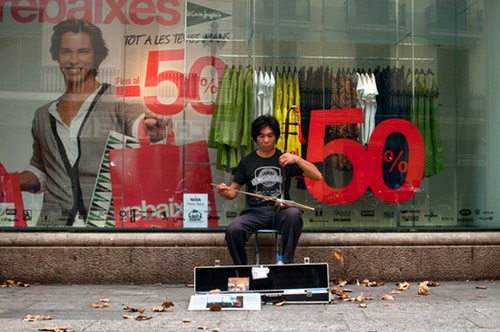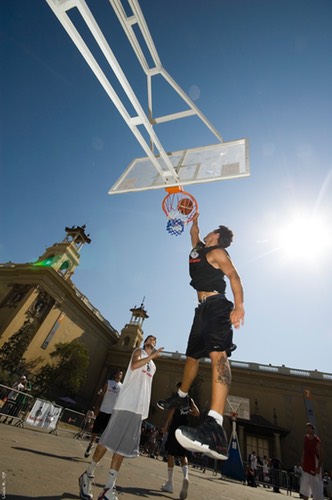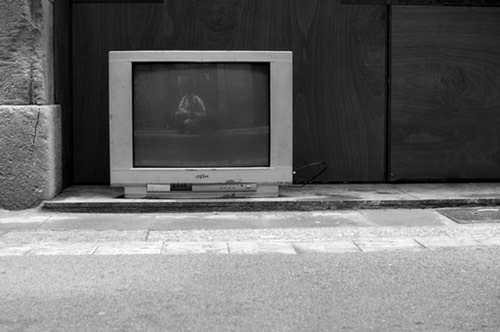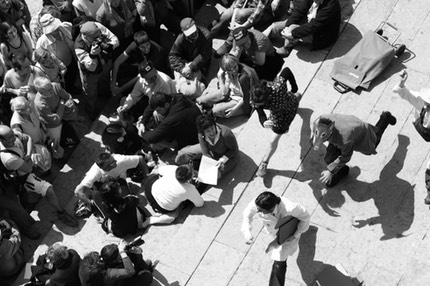The angle is the position of the camera in relation to the central theme of the photo. As you will see, position really influences composition. Depending on position, we can reinforce the theme of the photograph in one way or another.
This feature of composition can only be put into practice at the moment we take the photo; therefore it is important that we always keep it clearly in mind. Later in the lab, we cannot change the angle of the shot unless we’ve taken the same photo from every possible angle like they did in the film The Matrix, or if we simulate the angle by distorting it.
Let’s look at the most common angles.
Eye-Level Shot
This is when the position of the camera is at the same height as the subject of the photograph. It is a neutral and natural angle.
Low-Angle Shot
The low-angle shot involves placing the position of the camera below the subject of the photograph. The achieved effect is that of enhancing the subject, exalting it and giving it more importance.
Be careful when using the low-angle shot with close-up portraits. Usually the effect is the opposite and instead of enhancing the person, we create a caricature where the chin and the neck stick out in front of the rest of the face.
High-Angle Shot
This consists in placing the position of the camera above the theme or subject of the photograph. Usually this diminishes the importance of the subject among the other components in the photograph. It makes the subject seem small and silly.
Worm’s-Eye Shot
A worm’s-eye shot is where the camera is at level with the ground. It’s an unusual viewpoint for people, which as a result will transport the viewer to another world.
It’s effective for bringing life to inanimate subjects in a photo.
Bird’s-Eye Shot
This is when you take a photograph from an angle at a perpendicular plane to that of the subject. Perspective is lost, which can be interesting for comparing the true proportions of different subjects in a photograph.
This is not an easy shot to get with medium- or large-scale subjects because you need to have a crane or to be suspended in the air to get the perfect perpendicular angle. But despite the difficulty of putting it to use, the fact is that the result can surprise us a lot.
Example 1 Eye-Level Shot

"Erhu davant de les compres", Barcelona (2009)
I took a photo of this erhu musician who was playing one day in Portal del Ángel. I used an eye-level shot, resulting in a very neutral and natural photo.
Example 1 Low-Angle Shot

"Un predicador", Londres (2009)
Example 2 High-Angle Shot

In this photo there are some friends and me on an excursion on the west coast of the United States. Using a rock, Mireia placed the camera above her and got this high-angle shot, in which the subjects look a little dwarfed by the impressive coastline.
Example 2 Low-Angle Shot

"Basquet 4", Barcelona (2007)
Another noteworthy example of a low-angle shot. In a game of basketball in the street, this player rises up like a giant in the photograph. Without a doubt, the effect is multiplied by the use of a wide-angle lens.
Example 1 Worm’s-Eye Shot

"L'infern d'un fotògraf", Barceona (2009)
This television was abandoned in a doorway in one of the streets of Barceloneta in Barcelona. The decision to squat down and take the worm’s-eye shot allows the viewer to enter into its world, a different world. What will the TV do? Where will it go?
Example 1 High-Angle

"Cadira", Barcelona (2007)
This chair, which was in one of the buildings in the old Hospital of Sant Pau, was alone in the corner. Taking advantage of the stairs I was able to compose the photo with a high angle. This highlights the chair’s fragility in a space where surely it doesn’t get much use.
Example 1 Bird’s-Eye Shot

"Manifestació Plataforma per a la Defensa de Collserola", Barcelona (2008)
A performance at the foot of the temple on Tibidabo allowed me to take this bird’s-eye shot. The angle of the sun at that hour of the morning, together with the angle of the shot, allows us to follow the performers via their shadows.
